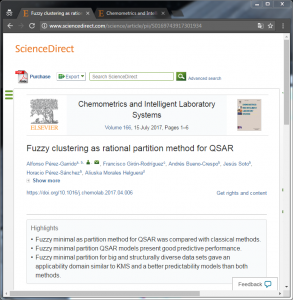 Las técnicas de Fuzzy Clustering podemos aplicarlas en diferentes campos. En este ejemplo tenemos una colaboración que busca mejorar los métodos QSAR, de técnicas computacionales relacionadas con el cálculo de propiedades fisicoquímicas moleculares.
Las técnicas de Fuzzy Clustering podemos aplicarlas en diferentes campos. En este ejemplo tenemos una colaboración que busca mejorar los métodos QSAR, de técnicas computacionales relacionadas con el cálculo de propiedades fisicoquímicas moleculares.
Abstract
Various methods are used to make the partition of data sets for QSAR development and model validation. In this work we used a fuzzy minimals partitioning and we compare this methodology with another rational partition methods like k-means clustering (KMS) and Minimal Test Set Dissimilarity (MTSD). For the development of QSAR models Ordinary Least Squares (OLS) and Extreme Learning Machine (ELM) methods were used. The generated QSAR equations were validated by the coefficient of determination of the internal leave one out (LOO) cross validation method QLOO 2 and then the coefficient of the external test set Qext 2 was compared between partition methods. The results of this comparison showed that using fuzzy minimal for big and structurally diverse data sets gave an applicability domain similar to KMS and a better predictability models than both methods, KMS and MTSD.